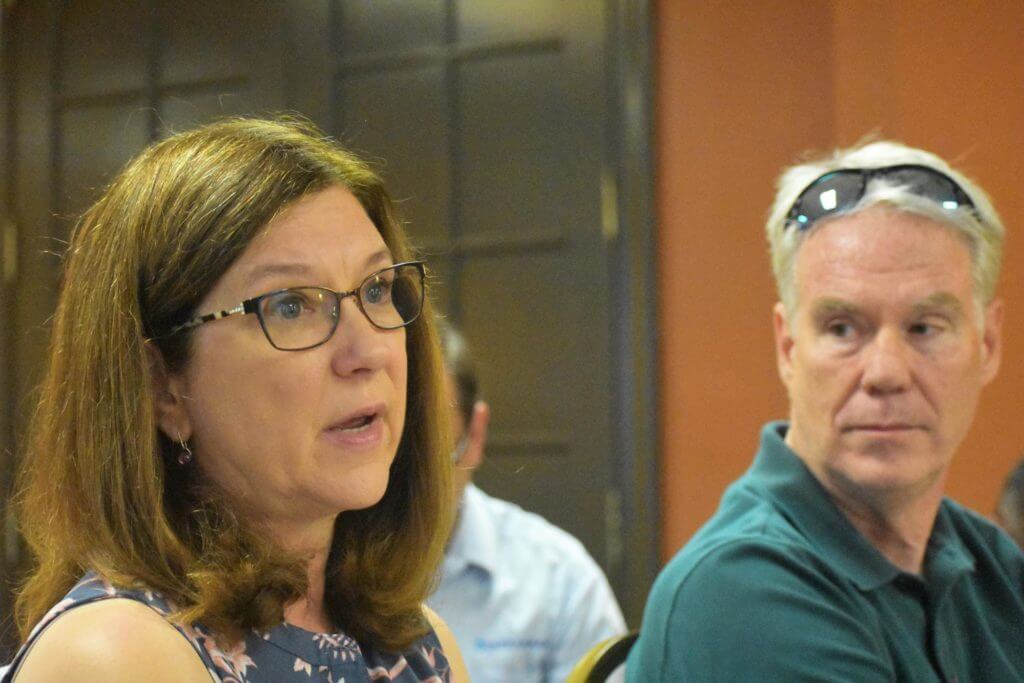
Trail revenue $35,000+
Considers for profit use
By LESLEE BASSMAN, Four Points News
Following months of discussions, the River Place Limited District Board won’t pursue further action to placate non-Limited District residents in regards to the neighborhood amenities including trails and tennis court usage.
Survey results
The decision followed a July 23 presentation of the results of a survey conducted by a board committee led by non-Limited District resident Kate Holloway that showed only five non-Limited District residents out of the 47 survey takers would be in favor of joining the District. If the non-Limited District residents were to pursue a process to join the District, the new residents would be required to pay District taxes but gain the right to use the neighborhood’s trails and tennis courts.
The survey, greenlighted by the Board in March, was confined to non-Limited District residents and its questions focused on whether there was sufficient interest among the group to become a part of the District. It was initiated by a non-Limited District Nextdoor group post on April 22 and closed May 31, Holloway said. On July 17, the Limited District board received the results, she said.
As previously reported by the Four Points News, Holloway said about 1,000 homes are located in the district and about 110 homes lie outside of the Limited District but within River Place. Within the Limited District, the 2018 appraised value of an average home, as determined by the Travis County Appraisal District, was $720,000 and the average appraised value in the non-Limited District is about $950,000, she said.
Comments on survey
One in five of the respondents stated they had previously lived in the MUD and now reside in an area outside of the Limited District created after River Place was annexed by the city of Austin a couple of years ago, Holloway said. Some of the comments on the survey reflect residents’ attitudes that “they had paid for the construction as well as maintenance of both the parks and trails and now were being charged additionally as compared to many folks who live in the (Limited District) portion of River Place who were new residents and lived there a relatively short time,” she said.
Holloway recommended the board review the comments added by respondents.
“These are your constituents and they certainly have some things to say about not only their own conclusions about joining the Limited District but they have some comments as well about how both the (homeowners association) and the (Limited District) has been run,” Holloway said.
Cortana Ridge and Milky Way are the largest areas within the non-Limited District, she said.
Optional annual fee
Since the survey was initiated, the board instituted an optional annual $400 fee per homeowner for non-Limited District members to access the community’s amenities. The majority of respondents mentioned they were in favor of this option, said Holloway.
Member Ivar Rochkind pointed out that not all Limited District expenses are covered by income from the tax.
“The Limited District taxpayers are not footing the complete expense (of these amenities),” Rochkind said.
However, the trail fee program has yet to make money.
Trail revenues/expenses
The revenue brought in from the trail program beginning at its March 23 inception through June is $35,580, said Michael Luft, bookkeeper for the District’s management company Inframark. He said the trail fee program’s costs of $8,677 through June include the project’s setup fee, signage, wristbands, vests and administration. The continuing costs for the program—including staffing, control, credit card administration—has tallied $34,969 through June, Luft said. Subtracting out some of the setup costs, the project is in the red by about $7,400, he said.
The ongoing costs look to be above water, said Luft who expects to be at the break even point once the setup costs are recouped. After that, he said he anticipates the project will earn about $500 a week in revenue over expenses.
Long term plans
Non-Limited District resident Robyn Sullivan asked the board what its long term plan is for the trail.
Crosby said the board will continue to modify the trail’s fee program implemented earlier this year.
“I think the original purpose of it was first and foremost for traffic safety so that continues to be a concern,” he said. “That has been, for the most part, controlled or eliminated with the fee.”
Crosby said the fees also go toward funding the Limited District. He said the board’s ongoing goal is to create “a financially viable district.”
“If there becomes a time in the future that we need to make (changes) or eliminate the program, that will be up to a future decision of the board,” Crosby said.
For profit trail use
The use of River Place trails by Miraval Austin has prompted Limited District officers to consider contracting with the for-profit spa. The district has a policy for contracting with non-profit groups consisting of 25 or more individuals but lacks clarity for a commercial enterprise such as Miraval that shuttles its guests to the trail about three times a week.
Member Art Jistal said the business brought six patrons and a guide to the trail last week, from about 9:30 a.m. to noon, with most groups stemming from the spa being small.
Member Jennifer Mushtaler said the board has reached out to Miraval to discuss possible options for their use and invited its manager to the meeting but no representative showed up. She said the board never contemplated use of the trails by for-profit entities.
“If groups are using the trails to make a profit, we should share in that profit,” Crosby said.
The board directed its attorney to contact Miraval’s staff to discuss their options.
Calls to Miraval were not returned as of press time.

